Pokemon Puzzle League/Tetris Attack/Panel de Pon Chains
I really enjoy chains in the game. I will focus most on them. There is probably some fun to be had setting up really large combos (especially in the custom puzzle feature of Pokemon Puzzle League). I'll have to explore this more. Perhaps I'll do some study of creation of fun long chains in the custom puzzle mode.
How to practice
Pokemon Puzzle League allows custom puzzles. By setting up the examples below, and giving yourself a handful of moves, you can practice these over and over until you get them. Too bad there are no gray blocks; you'll have to use other colors, alternating, in place of the gray blocks.
Tetris Attack allows control of the demos. Hold the R shoulder button and select a "demo". You will be in control. You can rearrange the demo board for practice of advanced chains not taught in the demo.
Chains:
A note on classification
The classification scheme is largely based on the play strategy, as opposed to deeper patterns. A good example of this is "raised chains". These are fundamentally the same as chains formed from the bottom of falling stacks. The different classification is to allow them to be given less priority in the search strategy when playing, and also to help highlight them because they are likely to be more overlooked. When first learning to play, one may focus entirely on the bottom of falling stacks. This can be a block to later advancement. On a more personal level, I enjoy the "culture" of chains. Giving them different names makes it neat.
I haven't verified that the core engine of the game is precisely the same in Pokemon Puzzle League as it is in Tetris Attack (which this page was written based on). From some of the "compatibility" features that were included, I get the impression that care was taken to make the core engine identical.
I first got Tetris Attack for Super NES a couple of years ago. I enjoyed it greatly, playing it for many hours a day for almost a year (sob, why did it have to end?!?). I strive to get better at making chains, seeing how far I can stretch it. The discipline required is fun to practice. Especially with Pokemon Puzzle League, I'm realizing that there is also a higher-level strategy involved in versus games, which involves modulating the length of the chains, so being able to make long chains (15x and higher) isn't necessarily an advantage in versus. The AI definitely seems more challenging in Pokemon Puzzle League, and it's providing a nice new challenge. At first I considered this higher-level strategy to be kind of lame, but I'm seeing how it can be fun to the "endless/marathon" skills into a new higher-level framework for versus, intentionally ending chains.
Basic Chains
First, the most basic chains, as a foundation. If these are unclear, use the tutorial feature of the game to get acquainted with them. These are fairly simple, but still worth analysis. They involve moving panels around to set up for a chain. No critical timing is required.

This one is fun because you can swap the panel (in the third frame) out just before everything is going to fall, making this like a skill chain.

You have to fill a hole to get the panel in place for this chain.
Raised Chains
Next are raised chains. These work just like normal chains, except the next link in the chain isn't directly next to the previous. These may seem obvious, but they are usually harder to find, since you are usually looking for normal touching chain links

This is one of the most basic raised chains. Remember it!

These are different initial setups, all of which can be manipulated to get to the setup above.

A simple variation on the above chain is illustrated here.

As above, these are variations on the initial starting locations of the panels.

This is another common raised chain, only this time, it's a vertical stack falling. In the stack is a panel that will make a match when the stack lands.
Skill Chains
Skill Chains are chains that are not set up until after the match that starts it is already flashing. They are fairly easy, and Yoshi shows you some of them in the teaching mode.
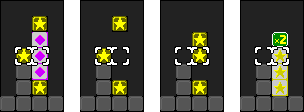
This is the easiest swap-in chains. It is so cool, though, how the falling panel sticks to the panel being swapped out, and then they both zoom down.
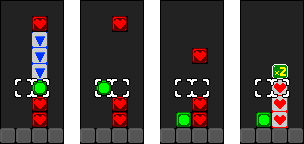
This is one of the easiest. The wrong-colored panel is swapped out of the way after the trigger match occurs, before the stack of panels falls in place to make a chain.

This is my favorite skill chain. It demonstrates an idea of "conservation of height". From left to right, we have height 1, height 2, and height 0 (after the panel falls). We swap the panel out of the middle stack, to the right stack. Subtract one from the middle, add one to the right. We now have height 1 for all three stacks, and get a match. This is math!

A swap is made just before the trigger match finishes. There is a delay as the swap occurs, then the two panels on the right fall in place and a chain forms.

A variation on the above, but harder. The swap-under above allows you more time to go on and set up more chains, while this requires you to wait longer before the swap. It is also harder to get the timing right.

The above swap-over with a combo added.
Advanced Chains
Now we move on to more-advanced chains which require precise timing or lightning-fast speed. They give the game a good learning curve.

The timing is difficult here. You need to drop the left panel just before the red panels drop, not after. This illustrates how there is a split-second where the right two panels are floating, yet there is really nothing under them, not even matched panels.

This one is fun, like the swap-in skill chain. You swap just after the matched panels disappear. Then the top panels fall and stick to the panel under the place where you swapped. This stack falls and then makes a chain.

This is a simple combo added to a normal chain. Swap just as the panels fall. Easy.
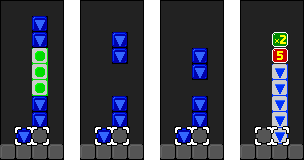
This is also a simple combo added to a normal chain. Again, swap just as the panels fall. Difference: Not easy. Not easy at all.

The swap must be made just as the group of panels lands. There is some room for error (more than 1/60th of a second), so it's a bit easier than some of the advanced chains below.

This requires precise timing, and is one of the more difficult chains. You must swap just as the falling panel is in the correct place to make a match. It feels like you are swapping just after you should, "crushing" the falling panel, when you really aren't.

Same as above, in all respects. Doesn't look like it, huh? It's interesting that nothing has to be under the panel being swapped out. This opens lots of new possibilities.
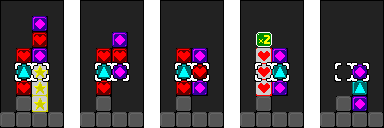
In this setup, the you "grab" a panel out of the falling stack, and put it in some stable panels to form a chain. The chain ability of the falling panel is preserved even when it is swapped. The timing is difficult (you must have 1/60th of a second accuracy).
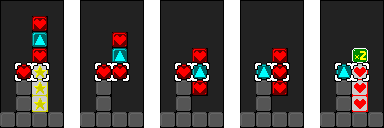
Same as above, but you place a panel from the stable stack into the falling stack. The match doesn't occur immediately; instead it is delayed until the stack lands, forming a chain. The timing is the same as above.

This one is interesting, and illustrates the property of panels not matching if they are lined up a little before they fall. Swap just before the stack falls, and the match will be delayed until the stack lands, forming a chain.

Same concept as above, only sort of impossible. I've done this twice in all my hours of playing Tetris Attack. It is very difficult.

This is a strange one I did accidentally when trying other chains out. The swap is made just after the panels fall.

Speed! This requires a very quick double-swap just after the match finishes. It took me a few months to finally get this. I would always try and try, but never get it. I figured it was impossible, but still kept trying whenever I had the chance. One day, I got it! Now I can do them most of the time. It's a fun one.
Time-Lag Chains
Here we have the most advanced chains: time-lag chains. They don't require the speed or precision of the advanced chains, but they instead require quick thinking and planning. They seem to be some of the most difficult, as they require more than one line of thought and planning, in general (maybe I'm thinking of what could be termed "Time-Lag Skill Chains"?). Another name for these could be "interleaved" or even "parallel" chains. It would be interesting if the game could discriminate between separate chains...

The first is the most basic time-lag chain, demonstrated by Yoshi in the teaching mode. The matches occur at different times, and count as separate links on the chain, instead of as a 6 combo.
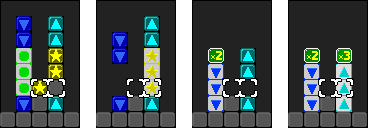
A concept that's important is that two separate chains still link together. The first one had already begun, while the second one was initiated by the player, totally separately. Yet they add up to an x3 chain.

This is fairly simple. It is of basic skill chain difficulty.
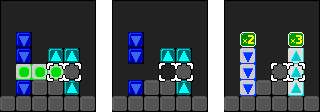
This last one is quite difficult. It is a combination of a normal chain and a swap-in chain. Since the swap in doesn't occur at the exact same moment as the left chain, the match for the right chain counts as a separate link, so an x3 chain is generated. This illustrates the fact that once panels fall, their chain-forming ability lasts a few moments. If this were not the case, the right-hand match wouldn't count as a chain (unless the swap occurred exactly as the panels fell, but then, it wouldn't count as a time-lag x3 chain).